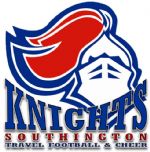Knights Lightning Policy

Background
Lightning occurs when a combination of natural weather conditions come together to create an electrical impulse. Lightning can occur many miles from the parent thunderstorm – outside the actual storm and visible thundercloud. Caution must be exerted as the storm approaches as for a substantial time after the storm.
The lightning charge may create heat as high as 50,000 degrees. It can contain up to 100 million volts of energy. While the energy of lightning is significant, death is generally a cardiac event.
The Southington Knights Midget Football League, Inc. (the “League”) has adopted this policy to give guidance to its members.
Emergency Plan
Prior to the individual practice/game, the outdoor weather should be noted. Practices and games are to be suspended after any lighting strike within 6 miles.
Avoid the Lightning Threat
Leaving the field of play (practice/game) Rule books put the authority in the hands of the referee to make the call to leave the field in inclement weather. However, it is important that members of the league, which include coaching staffs, give appropriate input to the officials prior to the decision to seek safe shelter or continue play. At a practice, coaches are urged to use common sense to provide a safe environment, but are expected to follow the directions of the Safety Director. Specifically, should the Safety Director suspend outdoor activities due to a lightning strike, all coaches are expected to suspend practice until receiving clearance to resume. A violation of this will result in discipline in accordance with the League’s Bylaws.
Outside Weather Observer A member of the coaching staff during practice/play, a member of the supervisory staff for the event, and other appropriate football or cheer related individuals shall advise the officials on the change of the weather. Parents, fans and like individuals with varied vested interests shall not be involved in this action.
Local Forecast A member of the league, Preferably the Safety Director or his/her designee, shall be assigned to monitor the weather forecast during the day. Changing weather conditions may make it necessary to bring in another individual to do the monitoring.
The league has established a lightning strike threshold of 6 miles. When a lightning strike has been detected within the 6 mile threshold, activities are to be suspended, and all players and team officials are to quickly seek shelter. Activities may not resume until it has been 30 minutes since the last strike within 6 miles.
Safe shelter shall be inside a substantial building, away from doorways, windows. Baseball/Softball dugouts are not appropriate. The shelter shall be able to keep the athletes and fans comfortable for up to 1 hour or more. Stay inside until 30 minutes after the last strike within 6 miles. While less than ideal, an enclosed motor vehicle will suffice. Avoid contact with the steering wheel, ignition, keys and/or radio. If one cannot get inside to a safe shelter, go to a lower elevation to minimize the risk. Stay away from fields, bleachers, trees, poles, light posts. Avoid unprotected open shelters, metal fences and structures. If still trapped outside where there is imminent risk of being struck, there are steps one may take. Imminent risk may be noted by the hair on arms and neck standing straight up, skin tingling, hearing a crackling sound. Move several feet away from another person and use the “lightning crouch” to minimize one’s risk. Put the feet together, squat down, tuck the head and cover the ears. When immediate threat of lightning has subsided go to a safe shelter.
Suspension of Play The recommendation from NWS, the NATA and the NFHS is that all athletes and fans shall remain in shelter for 30 minutes past the last lightning strike detected within 6 miles.
Lightning detection Lightning strike detection will be a multipronged approach. The Safety Director will follow weather forecasts for potentially severe weather, and in the event of an approaching storm use a lightning detector and mobile lightning detection services (WeatherBug, etc.) to monitor for strikes within 6 miles. In the event the Safety Director is unavailable, the league President will appoint a temporary official to monitor for lightning strikes.
Lightning detectors and detections services are not infallible. As such, team coaches and league officials should always use common sense. If you see lightning and then hear its associated thunder within 30 seconds, it is likely the strike occurred within 6 miles.
Emergency Care for the Injured
In the unfortunate circumstance that someone should be struck by lightning there are three key points to remember:
1.Activate your emergency plan;
2.Treat the injured person for a cardiac emergency immediately: CPR, EMS, AED;
3.Note that the injured person is no longer a threat to the rescuer as there is no continuation of electrical impulse through the victim.
This policy amended by the Board of Directors on August 8, 2019.
